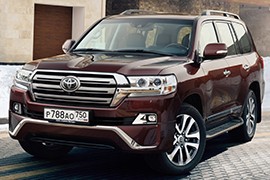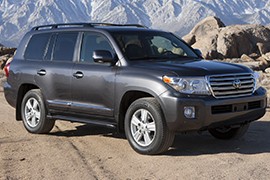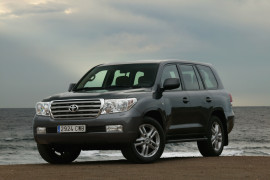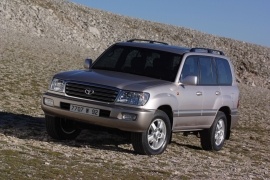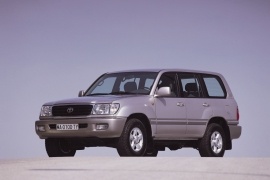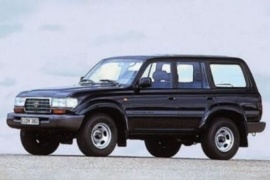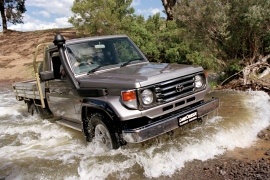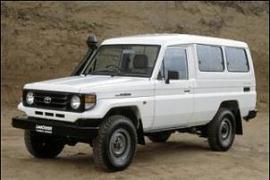TOYOTA Land Cruiser V8 and predecessors Models/Series Timeline, Specifications & Photos
First production year: 1984
Engines: Diesel, Gasoline
Body style: SUV (Sports Utility Vehicle)
In 2007, Toyota introduced the J200 generation of the Land Cruiser and offered it exclusively powered by V8 engines, hence the V8 nameplate, and eight years later, the automaker launched a heavily upgraded version of it.
The Land Cruiser was one of the best-known nameplates in Toyota’s inventory, and the Japanese automaker tried to use it for different vehicles. As a result, the lighter versions were named Land Cruiser Prado on selected markets, while the big, luxurious, and heavier model Land Cruiser J200 used just this nameplate, regardless of the market. Although that created some confusion among its customers, the chunky SUV found its fans thanks to the large cabin and powerful engines. Furthermore, along with the 2015 facelift, the bland exterior was refreshed and looked better.
With a bold front fascia that boasted a chunky chromed grille flanked by horizontal headlights, the Land Cruiser J200 was ready to face its difficult competitors in the large SUV segment. The main grille resembled the one installed on the Tacoma, which was an unknown model for European customers but very well known on the North American market. Furthermore, the hood featured two power bulges to emphasize the V8 engine underneath it. From its profile, the 2015 J200 Land Cruiser boasted a refined new look with integrated turn signals into the door mirrors and chromed trims on the lower part of the door panels.
Inside the cabin, Toyota offered a luxurious, leather-wrapped environment for up to eight people on three rows of seats. The automaker said that customers only had to choose upholstery color since everything else was fitted as standard. At the front, the occupants sat in comfortable, high-mounted seats separated by a wide center console that housed the transmission and a large cubby storage underneath the armrest. In front of the driver, the Land Cruiser J200 featured an instrument cluster filled with two large dials that flanked a TFT display between them and four additional gauges on the outer sides for several other critical information such as the fuel level and the ammeter on the right and fuel and coolant temperature on the left. Unlike the initial model, the 2015 J200 featured a large touchscreen atop the center stack for the infotainment system. Moreover, the new system was enhanced by a JBL Synthesis Premium Audio unit fitted with 14 speakers, including a subwoofer.
But the most significant changes happened under the car’s skin. While the gasoline-powered V8 engine remained the same as in the 2011 model year, the gearbox was upgraded. As a result, instead of a six-speed automatic, customers got a fresh eight-speed box that sent the power in all corners. Toyota kept the two-speed transfer case and the locking differentials on the standard features list, so buyers didn’t have to be afraid to drive their vehicles over rough terrains.
The big Toyota Land Cruiser V8/200 was unveiled in 2007 and it received a facelift in 2011. It was built to offer both performances on the road but still remain a tough offroad-er.
Despite having another version of the Toyota Land Cruiser, the 120 model, the Japanese car-maker decided to offer a more luxurious model, which was to continue the J100 model. Since it was a large SUV, it was fitted with diesel or gasoline V8 engines only.
The 2011 facelift brought a new front bumper design, with different fog lights on the corners. The headlights went through some changes, which affected the turn-signal lamps. Other subtle changes were adopted for the taillights.
Inside the car, the cabin was designed to provide a high level of comfort. The Land Cruiser 200 was available only in a luxury specification and it was fitted as standard with four-zone climate control, navigation system with HDD and a JBL sound system. The seven-seat layout allowed the rear seats middle seats to be folded into a split 40:20:40 system and the two rearmost seats folding to the side.
The 2011 Land Cruiser 200 was fitted as standard with a 6-speed automatic transmission. For the permanent all-wheel-drive system with a Torsen center differential. The transfer box allowed the driver to select a fixed 50:50 torque distribution and to select a low-range gear.
The Japanese automaker stepped up its game when it introduced the 2007 Land Cruiser, which was no longer just a capable offroad-er but also a luxurious vehicle.
While heavy is not good on an offroad trial, big is appreciated on luxurious vehicles. Toyota noticed that SUVs were trending and produced the 200 series of the Land Cruiser with deep-pockets customers in mind. Moreover, it even went over the edge and offered this behemoth with a V8 turbo-diesel powerplant for those who liked to spend more for a vehicle while saving some pennies for refueling it.
Its massive front fascia was clearly in a different league than the rest of the Land Cruiser series. Its broad grille with chromed horizontal slats created a powerful image for the vehicle. In addition, the swept-back headlights were tall enough to cover the entire area between the hood and the bumper. From its profile, the four-door bodywork was the only option and was granted with an additional set of windows behind the rear doors.
Inside, there was plenty of room for up to seven passengers since the automaker installed a pair of jump seats in the trunk area. At the front, Toyota installed a wide center console, which was more of an extension of the center stack that dominated the dashboard's design. An integrated infotainment system was placed atop it, providing the driver with additional information taken from the onboard computer or from the navigation system.
Under the hood, Toyota installed a choice of two V8 engines: one with gasoline available worldwide and a turbo-diesel for selected markets. Both were paired with an automatic transmission that sent the power in all corners via a two-speed transfer box.
In 1998, Toyota introduced the Land Cruiser 100 as an up-market, comfortable but truly hard-core off-road vehicle. Four years later, the carmaker refreshed the model.
The Land Cruiser is a worldwide respected name from Australia to Alaska and South Africa to the North Pole. It's a reliable vehicle that could go almost everywhere. But the Land Cruiser customers started to ask for more comfort. So, the carmaker introduced the J80 in 1990 and the J100 eight years later. For those who asked for a rugged vehicle, Toyota built the J105, which featured solid axles both front and rear, unlike the 100, which offered a more comfortable ride due to its front independent suspension.
The exterior was rounded, continuing the design trend started with the J80 series, but since the car was more prominent, its curves were hard to notice next to the large and flat body panels. Its enlarged wheel fenders emphasized the go-anywhere capability, while the body-colored door mirrors and the side-steps brought a touch of comfort and luxury for its owner.
Inside, Toyota offered the J100 with a wide choice of features and upholsteries. From a standard, manual gearbox, cloth seats, and a manual air-conditioning unit to a full version fitted with leather seats, climate control, and sunroof, the J100 had many options to choose from. A new suspension system made the ride even more comfortable for all the seven passengers that could fit inside the cabin thanks to a set of jump-seats in the trunk.
Under the hood, the J100 featured a 4.7-liter V8 gasoline engine for most of the markets. In some countries, Toyota installed a 4.2-liter inline-six turbodiesel, an engine known for its low-end torque.
Toyota introduced the Land Cruiser 100 as a replacement for the already beloved 80 series, which was already eight years old and needed couldn't keep the pace with its main competitors.
Designed to provide more power than the car it replaced, the new SUV from Toyota kept the nameplate standards at the same high levels in terms of reliability. Moreover, thanks to its longer wheelbase, it has increased the passengers' comfort. Its only drawback was its weight. But that didn't stop it from gaining the "4x4 of the Year in Australia."
Even though the design was nothing extraordinary, the LC 100 offered a commanding view on the road thanks to its tall and flat front area, like the aerodynamics never existed. Still, since it already started from the 80 series to show some curved lines, it continued. As a result, the front fenders sported enlarged areas around the wheels. Likewise, a similar enlarged area was applied around the wheels on the rear quarter panels.
The interior provided either a fabric or leather upholstery, depending on the options. The dashboard looked like a half-breed between a car and a truck, with a comprehensive instrument cluster that showed more gauges than a regular car. Still, the center stack was not something installed by truckmakers. Moreover, the tall center console created an individual area for both front occupants. There was room enough for three passengers in the middle row, while the last row offered two additional seats.
Under the hood, the carmaker dropped a 4.7-liter V8 with gasoline for most countries. At the same time, the 4.2-liter inline-six turbodiesel was the weapon of choice for Europe. Either way, it was a heavy vehicle that could still handle well off-road situations thanks to its all-wheel drive system and the two-speed transfer case.
The FJ80 was one of the best Land Cruiser vehicles ever made, and its legacy continued decades after it was withdrawn from the market.
With the introduction of coil-spring suspension, the Land Cruiser suddenly became a much more comfortable vehicle despite using rigid axles on both cars' ends. And don't get distracted by the more rounded design; it was still a competent off-roader but much more refined than its predecessor. No wonder it was one of the most sought-after vehicles from the Land Cruiser lineup. Yet, its price was way above other SUVs on the market.
Toyota introduced the Land Cruiser at the 1989 Tokyo Auto Show and in 1990 for other markets. Its rectangular headlights were the only sharp-edged parts of the vehicle. The rest was dominated by shaved corners and curved body panels. That made the big SUV look smaller, even though it was wider and longer than its predecessor. The slightly tilted and curved windshield and the tall side windows provided a luminous cabin. Yet, the flared wheel arches showed a muscular look for the vehicle, which was not for nothing.
Inside, the J80 was roomy and comfortable. It was available with standard cloth seats, while leather upholstery was available on higher trim levels. The low-mounted dashboard featured a raised area that covered the instrument cluster and the center stack, while the center console hosted the gear selector and the lever for the low-range transfer box.
While the diesel versions were named HZJ or HDJ, the gasoline-only models wore the FJ/FZJ badges. The spark-ignited Land Cruisers were powered by inline-sixes of 4.0 or 4.5-liter, fuel-injected engines. For the 1991 model-year, the FJ80 could barely break the speed limit in a quarter-mile sprint. Yet, in off-road sessions, it was helped by its low-range gear, the all-wheel drive system, and the center differential lock.
The rugged Toyota Land Cruiser FJ70 is a legend. Reliable, trustworthy, and able to cope with the hardest terrain on Earth, it was built as a troop carrier, closed cabin, or pickup-truck.
When it was time to replace the old Land Cruiser FJ40, Toyota introduced a bigger model: the FJ70 Series. It was built for extreme environments, it served under the U.N. Flag in peace-keeping corps and was used as an ambulance for war-zones. The pickup version was used to carry loads of materials over hard terrain, in conditions that would destroy almost any other vehicle.
Unlike its predecessor, the FJ70 featured an angular look. It resembled the shape of the FJ40, but with hard edges and flat surfaces. Since the side needed a profiled surface, the car-maker made that in angular shapes, making it easier to fix if a bent occurred and the owner cared. The FJ40 Pickup was available as a chassis-cab as well. For those fitted with a bed, side benches could have been installed to transport troops or workers.
The cabin was plain and simple, in a Japanese minimalist style. It was the purest form of form follow function design. The bench was wide enough to fit three people. The dashboard was flat, with only a few features for convenience such as the radio. For specific countries, an AC-unit was installed. The instrument cluster featured just three large dials: speedometer, fuel level, and coolant temperature.
The FJ was offered with gasoline and diesel engines, depending on the market. The stock version featured the 2F unit with an inline-six, 4.2-liter gasoline with a carburetor. Several diesel versions was installed later for specific markets but it received a different designation code as a BJ, HZJ or PZ.
The Land Cruiser FJ70 was considered one of the most reliable and trustworthy vehicles ever made, and the five-seater version made its way onto the harshest and most remote areas on Earth.
Toyota needed a replacement for the aging FJ40 lineup, which had been on the assembly lines since 1960, so it came with this: the FJ/LJ70 model. It was not only longer and more comfortable but also benefited from better engines. It was available in a few wheelbase versions and lengths, and the five-seat model with a longer cabin and two side doors was also used as a troop-carrier and was also known as the "Troopie."
The design was obviously not on top of Toyota's priority list when it made the FJ70. Thus, the flat front fascia featured a rectangular black plastic mold that served as a grille and featured round cutaways for headlights. To comply with safety regulations but keep the production costs down, it placed the parking lights and the blinkers on the corners. Behind the doors needed for the driver and side passenger, the automaker installed two side windows. At the same time, at the back, the automaker installed side-hinged doors to access the rest of the cabin.
Inside, it was cramped and a statement of form-follow-function. The dashboard was flat, with a squared instrument cluster placed in front of the driver. Depending on the version, the center stack accommodated the HVAC controls and a stereo. Apart from the front seats, the automaker offered the vehicle with side-mounted, inward-facing benches. Depending on the length version, it could carry up to six passengers on them.
Toyota produced the FJ70 with a wide range of gasoline and diesel engines, depending on the market. The base version featured the 2F unit with a carbureted inline-six, 4.2-liter gasoline.
